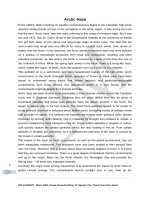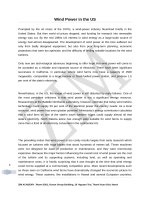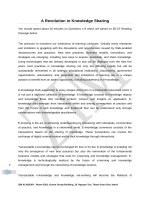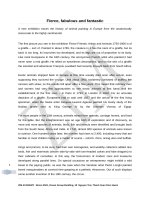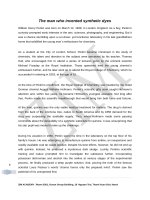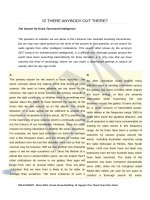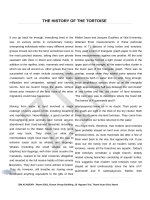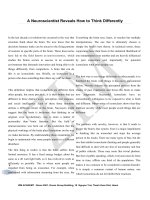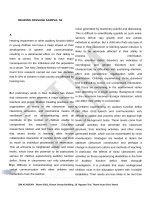IELTS academic reading sample 44
Bạn đang xem bản rút gọn của tài liệu. Xem và tải ngay bản đầy đủ của tài liệu tại đây (53.92 KB, 5 trang )
Wind Power in the US
Prompted by the oil crises of the 1970s, a wind-power industry flourished briefly in the
United States. But then world oil prices dropped, and funding for research into renewable
energy was cut. By the mid 1980s US interest in wind energy as a large-scale source of
energy had almost disappeared. The development of wind power at this time suffered not
only from badly designed equipment, but also from poor long-term planning, economic
projections that were too optimistic and the difficulty of finding suitable locations for the wind
turbines.
Only now are technological advances beginning to offer hope that wind power will come to
be accepted as a reliable and important source of electricity. There have been significant
successes in California, in particular, where wind farms now have a capacity of 1500
megawatts, comparable to a large nuclear or fossil-fuelled power station, and produce 1.5
per cent of the state’s electricity.
Nevertheless, in the US, the image of wind power is still distorted by early failures. One of
the most persistent criticisms is that wind power is not a significant energy resource.
Researchers at the Battelle Northwest Laboratory, however, estimate that today wind turbine
technology could supply 20 per cent of the electrical power the country needs. As a local
resource, wind power has even greater potential. Minnesota’s energy commission calculates
that a wind farm on one of the state’s south western ridges could supply almost all that
state’s electricity. North Dakota alone has enough sites suitable for wind farms to supply
more than a third of all electricity consumed in the continental US.
The prevailing notion that wind power is too costly results largely from early research which
focused on turbines with huge blades that stood hundreds of metres tall. These machines
were not designed for ease of production or maintenance, and they were enormously
expensive. Because the major factors influencing the overall cost of wind power are the cost
of the turbine and its supporting systems, including land, as well as operating and
maintenance costs, it is hardly surprising that it was thought at the time that wind energy
4
could not be supplied at a commercially competitive price. More recent developments such
as those seen on California wind farms have dramatically changed the economic picture for
wind energy. These systems, like installations in Hawaii and several European countries,
ZIM ACADEMY | Room 2501, Ocean Group Building, 19 Nguyen Trai, Thanh Xuan Dist, Hanoi
have benefited from the economies of scale that come through standardised manufacturing
and purchasing. The result has been a dramatic drop in capital costs: the installed cost of
new wind turbines stood at $1000 per kilowatt in 1993, down from about $4000 per kilowatt
in 1980, and continues to fall. Design improvements and more efficient maintenance
programs for large numbers of turbines have reduced operating costs as well. The cost of
electricity delivered by wind farm turbines has decreased from about 30 cents per kilowatthour to between 7 and 9 cents, which is generally less than the cost of electricity from
conventional power stations. Reliability has also improved dramatically. The latest turbines
run more than 95 per cent of the time, compared with around 60 per cent in the early 1980s.
Another misconception is that improved designs are needed to make wind power feasible.
Out of the numerous wind turbine designs proposed or built by inventors or developers, the
propeller-blade type, which is based on detailed analytical models as well as extensive
experimental data, has emerged as predominant among the more than 20,000 machines
now in commercial operation world-wide. Like the gas-driven turbines that power jet aircraft,
these are sophisticated pieces of rotating machinery. They are already highly efficient, and
there is no reason to believe that other configurations will produce major benefits. Like other
ways of generating electricity, wind power does not leave the environment entirely
unharmed.
There
are
many
potential
problems,
ranging
from
interference
with
telecommunications to impact on wildlife and natural habitats. But these effects must be
balanced against those associated with other forms of electricity generation.
Conventional power stations impose hidden costs on society, such as the control of air
pollution, the management of nuclear waste and global warming. As wind power has been
ignored in the US over the past few years, expertise and commercial exploitation in the field
have shifted to Europe. The European Union spends 10 times as much as the US
government on research and development of wind energy. It estimates that at least 10 per
cent of Europe’s electrical power could be supplied by land-based wind-turbines using
current technology. Indeed, according to the American Wind Energy Association, an
independent organisation based in Washington, Denmark, Britain, Spain and the
Netherlands will each surpass the US in the generating capacity of wind turbines installed
during the rest of the decade.
4
ZIM ACADEMY | Room 2501, Ocean Group Building, 19 Nguyen Trai, Thanh Xuan Dist, Hanoi
1 Which one of the statements is true?
A) Cost was a big factor in preventing the development of wind power
B) Wind power can provide enough electricty for the United States
C) Some US states are powered solely by wind
D) Wind power has developed steadily since the 1970s.
2 What is the general view of wind energy in the United States?
A) Very positive
B) It can only provide small amounts of energy
C) It will reduce global warming
D) Very negative
3 Which of these factors has not contributed to the reduced cost of wind energy?
A) State subsidies
B) Economies of scale
C) More efficient maintenance
D) Standardisation of design
4 Wind turbine designs ...
A) Are already very good
B) Will be much more efficient in the future
C) Are expected to improve in the future
4
D) Are good for the environment
5 Wind energy is more developed in Europe than the USA
ZIM ACADEMY | Room 2501, Ocean Group Building, 19 Nguyen Trai, Thanh Xuan Dist, Hanoi
•
False
•
True
4
ZIM ACADEMY | Room 2501, Ocean Group Building, 19 Nguyen Trai, Thanh Xuan Dist, Hanoi
Answer:
1. B
2. C 3. A
4. A 5. TRUE
4
ZIM ACADEMY | Room 2501, Ocean Group Building, 19 Nguyen Trai, Thanh Xuan Dist, Hanoi
